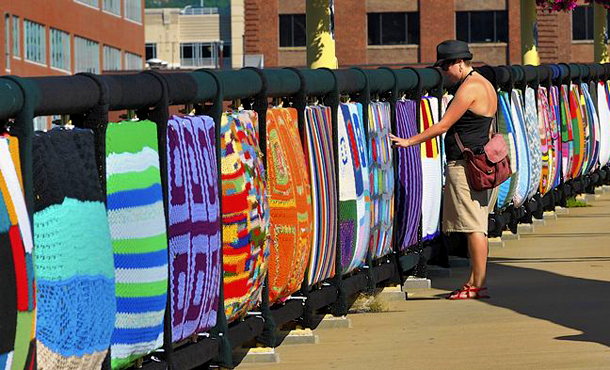It was covered by the BBC and NPR, Time.com and the Huffington Post and by media in Europe and Israel.
The vast, improbable, record-breaking Knit the Bridge project – in which the 1,061-foot-long Andy Warhol Bridge was covered with 580 knitted and crocheted blankets during the second weekend of August – is officially a success, according to organizers, public officials, knitting enthusiasts, yarn bombers and people on the streets of Downtown.
Today [Sept. 6] is the last day to see the largest such “yarn bombing” of a structure in the United States and possibly in the world, before a team of volunteers arrives at 5 a.m. Saturday to start dismantling the project. The bridge will be closed until 7 p.m. Sunday as volunteers undo the thousands of plastic ties fastening the acrylic yarn panels to the structure, said Amanda Gross [EMU ’07, MA ’13], a local fiber artist who came up with the idea for the Knit the Bridge project.
As the city basked in warm September sunshine Thursday, those strolling near the 87-year-old steel suspension bridge gave the project rave reviews.
“We don’t have anything like this in Seattle,” said Karen Michaelis, a Bethel Park native who has lived in Bellingham, Wash., for the past 30 years and was visiting family. “It gives the city a great ambiance. This is really big.”
“It’s a little bit artsy, a little bit homey,” added Alyssa Knierim, 21, of Oakland, who was power walking along the Allegheny River front. “It just gives Pittsburgh a hipper vibe.”
Craig Davis, president and CEO of VisitPittsburgh, said he was “thrilled” with the media attention given to the project, sponsored by the Fiberarts Guild of Pittsburgh with help from the Pittsburgh Center for the Arts.
“The news coverage of this fun, art event helped solidify Pittsburgh’s growing reputation as a hip city that is rich in art and culture,” Mr. Davis said.
Coincidentally or not, the Andy Warhol Museum, which was not officially affiliated with the project, saw an increase in visitors during the month of August over last year – up from 9,520 in 2012 to 10,560 this year, an increase of 1,040.
“I’ve been here 18 years, and I’ve never seen so much foot traffic on that bridge,” said Rick Armstrong, the Warhol’s director of communications.
Not only did the project showcase the city’s “vibrant arts community on one of our signature Downtown bridges, it didn’t cost the taxpayers any money,” added Allegheny County Executive Rich Fitzgerald.
It might seem a simple enough idea – attaching knitted panels to the side of a bridge – but the project, involving 1,900 people, was a “massive logistical undertaking,” Mr. Fitzgerald added, noting that during meetings of the artists, organizers and members of the county’s public works department, “we couldn’t really ask, ‘How did they do this in St. Louis?’ because nothing like this had ever been done before.”
After the blanket panels are removed from the bridge, they will be laundered and distributed to homeless shelters and nursing homes, said Jay van Wagenen, director of the Fiberart International, a triennial juried exhibition sponsored by the Fiberarts Guild of Pittsburgh.
More than 90 percent of the county’s municipalities had someone participating in the project, “and I was really surprised at the tremendous enthusiasm by the public,” she said.
Ms. Gross, with a master’s degree in conflict transformation from Eastern Mennonite University, is trained in peace building through the arts. During the planning for the most recent Fiberarts Guild of Pittsburgh exhibition, she “took an esoteric concept out into a much wider community than we usually do,” Ms. van Wagenen said.
In the past, the exhibition’s community outreach piece might have involved an artist-in-residence at a school, “but Amanda made it considerably larger and more accessible to people. We had teenage boys knitting, we had knit-ins all over the place, we had people saying, ‘Oh, I have a friend from Brooklyn or Seattle who will contribute something.’ It was tremendous.”
Article courtesy Pittsburgh Post-Gazette, Sept. 6, 2013
